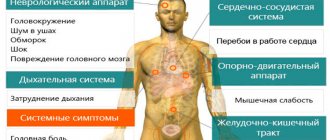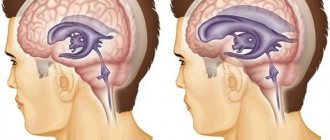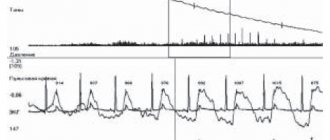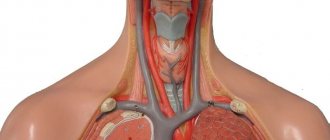You can determine pulse pressure by simply monitoring the frequency of the latter in the wrist area - if less than 60 beats per minute is recorded, this indicates a decrease in blood pressure, and 70-90 beats per minute or higher indicates an increase in blood pressure. There is a pendulum method, it cannot be explained by science, it is not confirmed by official medicine, but it provides fairly clear data.
The accuracy of pulse pressure measurement is very low, but these methods can be used for general monitoring of the functioning of the cardiovascular system.
What is pressure?
Pressure represents the amount of blood supply and movement through the vessels. Depending on the health of body functions, pressure may vary. The indicator is considered individual, but the approximate norm is 120 to 80.
Blood pressure depends on the amount of fluid moving through the vessels. In this regard, there are factors that can influence the excess of this indicator.
An increase in the amount of fluid occurs for the following reasons:
- Retention of excess moisture in the body occurs due to excessive salt consumption. For example, drinking a large amount of beer together with a salty snack in the morning will provoke swelling of the face, and the excessive load on the blood vessels will remain an invisible problem. You should avoid eating sausages, canned food, and smoked foods.
- Atherosclerosis is also a cause of fluid retention, since the disease refers to blockage of blood vessels, their slagging. Avoiding trouble will help you avoid fatty foods and follow a diet based on proper nutrition.
- Hormonal imbalance is also one of the reasons for the insufficient functioning of blood vessels and the retention of excess in the body. At the same time, there is a decrease in the speed of all existing processes in the body.
- Overeating and increased water consumption affect the amount of fluid moving through the vessels.
- Bad habits: smoking and alcohol affect the health of blood vessels, gradually narrowing the lumen. This reduces the quality of blood circulation in the body.
How can you help?
The treatment regimen is presented in the table.
Table 6. How is treatment carried out?
| Reason for violation | How to fix it? |
| Elimination of fluid deficiency in the body. |
| Stop bleeding, replenish the volume of circulating blood. Intravenous administration of medicinal solutions is prescribed. |
| Use of electrical cardioversion. |
| Detoxification of the body, introduction of antidotes. In more complex cases, hemodialysis is prescribed. The blood is cleansed of poisons using an artificial kidney apparatus. |
| Dosage adjustment or discontinuation of the provoking medication. |
| Anemia. | Increasing the level of red blood cells and hemoglobin in the blood. The patient is prescribed the use of iron supplements. In difficult cases, the doctor resorts to donor blood transfusion. |
| Valve replacement surgery. |
Pressure norm
Pressure is an individual indicator, which depends on environmental conditions, age, the presence of problems in the body, and even the time of day. There is a medical norm, in relation to which the doctor assumes any changes in the patient’s body.
Normal pressure is pressure that was measured according to rules that assume that the person was at rest and was not physically and emotionally stressed. High blood pressure is considered to be that which has risen above 140 to 90. It already indicates the presence of a serious malfunction in the body
As you grow older, irreversible changes occur in your body, causing your normal blood pressure levels to increase. This is associated with some loss of health of certain organs, including blood vessels and the heart. A deviation from the norm is not only high, but also low blood pressure. A decrease may relate to disorders of the cardiovascular system, an increase may relate to heart pathologies.
Regular measurement of blood pressure and pulse can help avoid serious consequences, since changes will be visible at the initial stage.
Possible mistakes
Many people, when trying to measure blood pressure using their pulse rate, make mistakes and, as a result, receive false information about the state of their health. During diagnosis, it is necessary to take into account not only the number of heartbeats, but also their rhythm.
Sometimes it is arrhythmias that provoke pressure surges and in this case drug treatment is required. As soon as the heart muscle normalizes its rhythm, the unpleasant symptoms will disappear.
And also read on our website: What does a low pulse mean with low blood pressure: what to do, how to provide first aid and how to treat?
It is also a common mistake to measure your heart rate only from your wrist. The heartbeat can also be clearly heard in other areas - under the knee joint, on the temples, on the neck. It is important to compare the indicators obtained at different points and only then draw conclusions. Strong pulsation on one arm and weak pulsation on the other cannot be considered normal. Only a doctor can accurately calculate blood pressure using the pulse.
The inability to correctly interpret the data received or measure the pulse will lead you to many negative thoughts, which, as a rule, are one of the main causes of pressure surges.
Reasons for changes in pressure
The change in pressure can be short-term, but can also be systematically repeated. The reasons may be:
- Sensitivity to food, including allergic reactions;
- Hormonal imbalances;
- Stress;
- Diseases of the genitourinary system;
- Alcohol abuse and smoking;
- Heart failure;
- Poor nutrition;
- Diseases of the digestive system;
- Changes in weather conditions;
- Use of medications;
- Overwork.
Technique for measuring pressure using a pendulum and ruler
When there is no tonometer at hand, a pendulum will replace it. It can be a ring, a sewing needle, a washer, or a wire bent into a ring.
A step-by-step description of how to measure pressure using a pendulum is as follows:
- Prepare the items you will need to measure your blood pressure. You will need a ruler about 25 cm or a piece of squared paper; wedding ring or sewing needle.
- Free your hand from clothing. Place a ruler on your hand, more precisely on the inside of your forearm.
- Thread a thread through a ring or take a thread and a needle.
- Move the resulting pendulum along the ruler as close to it as possible, starting from the elbow bend. As soon as the pendulum begins to swing or spin on one of the numbers, this means that this is an indicator of the upper pressure. For example, if it fluctuates at around 13 cm, the indicator is multiplied by 10. This means that the upper pressure is equal to 130.
- Continue moving the pendulum towards your wrist. As soon as he starts moving again, you should remember the number. For example, near 8 cm, multiply by 10, the result is a lower pressure equal to 80. As a result, the pressure is equal to 130/80.
Many people conducted this experiment by then measuring their blood pressure using a tonometer. It's interesting that it coincided.
This method of determination is simple and allows you to find out the indicators without having a special device. The procedure takes a little time.
Why do you need to measure blood pressure?
High blood pressure can now also affect young people. The problem of hypertension is acute, and this can lead to irreversible consequences.
Symptoms of hypertension:
- Floaters before the eyes;
- Tinnitus;
- Redness of the skin;
- Irritability;
- Chills;
- Sleep problems;
- Anxiety;
- Deterioration of vision;
- Weakness;
- Deterioration in performance and memory;
- Cardiopalmus;
- Sweating;
- Headache;
- Dizziness;
- Nausea.
Symptoms can appear separately or in combination for a short time, pass after sufficient rest and return with renewed vigor. It is easy to miss the disease at the initial stage, since it looks like ordinary overwork. When you contact a specialist on time, you have a chance to get rid of symptoms and forget about the disease by adjusting your lifestyle.
Advanced hypertension may one day manifest itself with an attack; the outcome may be complicated by the following disorders:
- Stroke;
- Heart attack;
- Brain swelling;
- Pulmonary edema;
- Death.
A hypertensive crisis is characterized by a sharp deterioration in health, obvious manifestation of symptoms, including vomiting. When it occurs, you should call an ambulance. While waiting, the patient needs to take a comfortable position, calm down, relax, and, if necessary, take a sedative and an extra dose of medication for hypertension. A cold compress is applied to the forehead and heating pads are applied to the legs for 15 minutes.
Causes of tachycardia due to hypotension
The main reasons for increased heart rate due to low blood pressure are presented in the table.
Table 2. Why does heart rate increase and blood pressure decrease?
| Cause | Provoking factor |
| Anemia | The level of red blood cells and hemoglobin in the blood decreases. |
| Often found in people suffering from VSD. Characterized by the appearance of sudden and painful fear that is uncontrollable. The attack is accompanied by increased heart rate, sweating, and dizziness. Its duration is 1-10 minutes. |
| The symptom occurs against the background of an overdose. |
| The symptom is due to the appearance of side effects. |
| Blood pressure decreases while eating. |
| Occurs when a person assumes a vertical position. |
| Characterized by a sharp jump in thyroid hormones. |
| The symptom occurs due to cyanide poisoning. |
Note! During a heart attack, the pulse can reach 50-60 beats/60 seconds. In this case, blood pressure rises to 180-190/100-105 mm Hg. Art. Against this background, there is a risk of cardiogenic shock.
How to determine pressure by pulse
Without a device, it is impossible to accurately determine the pressure, so a pulse determination method is proposed. To do this, you need to place your index and ring fingers on your wrist and apply pressure. The radial pulse can be measured in 30 seconds by placing a watch with a second hand in front of you.
The counted beats must be multiplied by two to get the number of beats per minute. With increased pressure, the pulse is clearly palpable, but with low pressure, it disappears with pressure and becomes imperceptible. In an adult, a pulse of 60-80 is considered normal.
By placing two fingers on the carotid artery, you can also measure your pulse rate. Measurement using these methods is quite accurate, but if you have a heart rate monitor, you can use its main function and get data immediately. There are chest and wrist heart rate monitors; they are used mainly by athletes for optimal load distribution.
If you listen to yourself and try to describe a headache: with high blood pressure, there is pain in the back of the head and temples, characterized by particular severity, strength and sharpness, and may be accompanied by nausea and vomiting; with low blood pressure, the pain affects the frontal and temporal regions and is described as dull and pressing.
A clear symptom of high blood pressure is redness of the skin. Pay attention to your body and face, if there is a vascular network, then the pressure is increased. With low blood pressure, the opposite effect occurs: the face will have a pale, sallow tone.
General health can also tell a lot about blood pressure. A feeling of weakness, a blurred “picture” before the eyes, ringing in the ears, nervousness, and problems sleeping indicate an increase in blood pressure above normal. If these symptoms recur after rest and sleep, you should definitely consult a doctor.
Instructions
The ruler should be placed on the inside of the hand (so that the palm faces up). Before you start measuring pressure, you need to raise and lower the hand itself several times
As soon as the tonometer appeared, we compared the readings. They turned out to be the same.
Your dowsing with golden rings and dancing with the shaman will lead to a crisis!
This method can ONLY be used by hypersensitive people, who are called psychics; there are only a few of them on earth, alas.
Go to your neighbors for a tonometer if you suspect a change in blood pressure.
I was specifically looking for a method of measuring blood pressure without a tonometer. And I found it. I have been using this method for many years. I have had and still have blood pressure monitors. automatic and semi-automatic machines. They are all very expensive, but there is no accuracy!
Lately I have abandoned all blood pressure monitors and carry a 15cm ruler and a nut on a string with me in my purse. Super! And more than once I was convinced of the accuracy of the measurement when I was in the hospital and, before visiting the doctors, I deliberately measured the blood pressure of myself and my roommates. So the “grandmother’s” method works great! And I, an ordinary person.
1. Take a sitting position, turn your shoulders, put your hand on the table. When measuring blood pressure, your wrist should be at the same level as your heart. Adjust the height of your wrist and elbow by placing a rolled up towel or a small pillow. Find the spot on your wrist where you can feel your pulse. Take 5-6 deep breaths to remove any unnecessary anxiety.
2. Tie a woolen thread about 40 cm long to a gold ring without stones (preferably smooth). Pass the thread through the ring and tie it in a knot. The ring will act as a pendulum.
3. Place a wooden ruler along your arm, aligning the zero mark on the scale with the location of the detected pulse beat. Take the thread by the knot in your other hand and place it on your elbow so as to align the position of the ring with the zero mark on the ruler scale. When the ring “feels” the pulse, it will begin to swing or spin. Align this point with the zero on the ruler.
4. Slowly move the thread with the ring along your arm towards your elbow. The ring will calm down. But it will begin to sway again in a place that coincides on the scale with the lower blood pressure level (in millimeters). Remember it and continue to move the ring further. Next time the ring will spin and show your upper blood pressure level. Once you have both numbers, write them down.
5. Repeat the measurement several times after 2–3 minutes. The need to measure blood pressure several times a day often brings unnecessary worries. As a rule, the indicators of the first approach therefore turn out to be overestimated. Please take this into account when determining your results.
6. There is another method to measure pressure with a ring - when the ring is an electronic tonometer sensor worn on a finger. And although there is a certain convenience when taking measurements (for example, you do not need to take off your outer clothing, it is convenient to use on the road, while driving), the error of such a device is quite large.
1. Take a sitting position, turn your shoulders, put your hand on the table. When measuring blood pressure, your wrist should be at the same level as your heart. Adjust the height of your wrist and elbow by placing a rolled up towel or a small pillow. Find the spot on your wrist where you can feel your pulse. Take 5-6 deep breaths to remove any unnecessary anxiety.
2. Tie a woolen thread about 40 cm long to a gold ring without stones (preferably smooth). Pass the thread through the ring and tie it in a knot. The ring will act as a pendulum.
3. Place a wooden ruler along your arm, aligning the zero mark on the scale with the location of the detected pulse beat. Take the thread by the knot in your other hand and place it on your elbow so as to align the position of the ring with the zero mark on the ruler scale. When the ring “feels” the pulse, it will begin to swing or spin. Align this point with the zero on the ruler.
4. Slowly move the thread with the ring along your arm towards your elbow. The ring will calm down. But it will begin to sway again in a place that coincides on the scale with the lower blood pressure level (in millimeters). Remember it and continue to move the ring further. Next time the ring will spin and show your upper blood pressure level. Once you have both numbers, write them down.
5. Repeat the measurement several times after 2–3 minutes. The need to measure blood pressure several times a day often brings unnecessary worries. As a rule, the indicators of the first approach therefore turn out to be overestimated. Please take this into account when determining your results.
6. There is another method to measure pressure with a ring - when the ring is an electronic tonometer sensor worn on a finger. And although there is a certain convenience when taking measurements (for example, you do not need to take off your outer clothing, it is convenient to use on the road, while driving), the error of such a device is quite large.
Criteria for high blood pressure
The following characteristic changes in the body may indicate problems with blood pressure:
- Stomach. A sedentary lifestyle and poor nutrition lead to problems with the body's systems, including the cardiovascular system.
- Complexion. Red skin indicates high blood pressure, pallor indicates low blood pressure.
- Red eyes. Visual impairment is one of the symptoms of hypertension, so the condition of the eyes is indicative.
- Pulse. Increased pressure is felt when pressing on the wrist, decreased pressure is not felt or stops with pressure.
- Dyspnea.
- Pain in the heart area.
- Pain in the back of the head.
Features of drug therapy
Groups of drugs that are prescribed to normalize heart rate and blood pressure are presented in the table.
Table 7. What medications are prescribed?
| Group of drugs | Description |
| They help reduce the intensity of contraction of the ventricular muscles, reduce the permeability of cells to calcium ions. |
| Accompany a decrease in the permeability of cell membranes to sodium and calcium. The principle of action is similar to that of calcium channel blockers. |
| They help block signals from the sympathetic part of the nervous system. Affects cardiac receptors. Reduce the risk of relapse. |
| Change membrane permeability. Against this background, the transfer of electrical potential slows down. The most serious side effect is arrhythmia. |
High blood pressure and high pulse
The drugs prescribed to normalize the indications are presented in the tablet.
Table 8. Medications for high pulse and high blood pressure.
| A drug | Description | Price |
| Cardioselective blocker of alpha-blockers. Does not have an internal symptomatic, membrane-stimulating effect. It has a hypotensive, antianginal and antiarrhythmic effect. | From 20 rubles. |
| Non-selective beta blocker. It has antihypertensive, antianginal and antiarrhythmic effects. Prevents headaches and relieves tremors. | From 20 rubles. |
| ACE inhibitor. It has a powerful hypotensive effect and reduces platelet aggregation. | From 24 rubles. |
| The medicine belongs to the group of angiotensin-converting enzyme inhibitors. A complex drug that has a hypotensive and diuretic effect. Has a beneficial effect on the cardiac and vascular systems. | From 36 rubles. |
| A combined medicine with antispasmodic and sedative effects. The hypotensive effect is insignificant. | From 132 rubles. |
Note! Uncontrolled use of drugs in this group can cause adverse consequences caused by a sharp drop in blood pressure.
High pulse and low or normal blood pressure
Drugs that reduce heart rate and do not affect blood pressure are presented in the table.
Table 9. Decrease in heart rate without decrease in blood pressure.
| Medicine | Description | Price |
| Tranquilizer, benzodiazepine derivative. It has an anxiolytic, muscle relaxant and antiepileptic effect. It has a slight sedative effect and relieves psychoneurotic tension. | 167 rubles. |
| It has anxiolytic, sedative-hypnotic, anticonvulsant and central muscle relaxant effects. Helps enhance the inhibitory effect of GABA on the transmission of nerve impulses. | 91 rubles. |
| A herbal preparation that has an antispasmodic and moderate sedative effect. Can be prescribed to children. | 245 rubles. |
Low pulse and high blood pressure
The patient is prescribed antihypertensive drugs. Drugs that directly reduce heart rate are not prescribed. When taking medications of this group, it is necessary to control the heart rate, avoiding bradycardia.
Table 10. Drugs that normalize pulse without increasing blood pressure.
| Medicine | Description | Price |
| ACE inhibitor. Stops the “birth” of angiotensin. Helps reduce peripheral vascular resistance and afterload. Normalizes blood pressure. Accompanies a decrease in preload and pressure in the pulmonary circulation. | 311 rubles. |
| A good antihypertensive drug. Inhibits ACE activity and helps reduce the formation of angiotensin II. | 128 rubles. |
| Prodrug. The hypotensive effect appears within 1-60 minutes after application. The maximum occurs after 4-8 hours. The effect lasts throughout the day. | 116 rubles. |
| It is a thiazide diuretic. Promotes disruption of the reabsorption of sodium, chlorine and water ions in the distal tubules of the nephron. Retains calcium ions in the body. Accompanies a decrease in blood pressure, an increase in the excretion of potassium, magnesium, and bicarbonate ions. The onset of the diuretic effect is observed after 120 minutes. The duration of the effect is 12 hours. | From 50 rubles. |
| Peripheral vasodilator. By reducing peripheral vascular resistance, it reduces blood pressure. Helps dilate peripheral veins and reduce afterload on the heart. | From 169 rubles. |
| It is a selective competitive blocker of postsynaptic alpha-adrenergic receptors. Promotes the expansion of peripheral blood vessels. This leads to a decrease in peripheral vascular resistance and a decrease in blood pressure. | From 167 rubles. |
Additional therapies
With the same pulse and blood pressure readings, one person feels normal, while another feels bad. The label provides information about additional therapeutic measures.
Table 11. Additional measures.
| Indicators | What should I do? |
| Normal work and rest schedule, sleep at least 8 hours, sports activity. It is advisable to visit the pool 2 times a week. |
| Get enough sleep, exercise, fill your diet with seasonal fruits, berries, and vegetables. |
| Daily Holter ECG monitoring is necessary. Only a doctor can prescribe medications. |
| 30 drops of Valocordin will help quickly bring your indicators back to normal. |
| This is a dangerous condition that may signal an infection. The patient requires urgent medical intervention. |
Interpretation of deviations from the medical norm
Deviations of pressure from the medical norm may be due to:
- Heart failure.
- Blood viscosity. Changes in blood quality are usually felt with changes in lifestyle and nutrition. Thick blood can also be caused by diabetes or an autoimmune system disease.
- Vascular pathology or deterioration in their quality. Excessive loads on the vessels reduce their elasticity, causing the quality of blood circulation to suffer.
- Presence of plaques. The slagging of blood vessels directly affects their patency.
- Hormonal changes that caused a narrowing of the lumen of blood vessels.
- Diseases of the endocrine system.
A little about the symptoms
In most cases, prehypertension can occur without associated symptoms. That is why this disease is popularly called the “silent killer.” For a long time, such an illness simply goes unnoticed, gradually complicating the patient’s condition. High blood pressure in an advanced stage can easily lead to a stroke or crisis. Therefore, systematic prevention of the disease and attempts to diagnose it in a timely manner should not be neglected.
However, the initial stage of the described illness may still manifest itself in the following symptoms:
- periodic pain in the head area (most often in the back of the head);
- body weakness;
- deafness, tinnitus, ripples in the eyes;
- decreased performance, increased fatigue, decreased concentration and memory;
- tachycardia, chest pain, shortness of breath with minimal physical exertion;
- fainting, dizziness, confusion;
- constant feeling of anxiety, increased excitability, aggression;
- redness of the face and skin, a feeling of heat, the appearance of a pronounced network of capillaries throughout the body;
- numbness of fingers, swelling of hands and face;
- damaged blood vessels in the fundus of the eye.
A separate topic in the issue of hypertension is hypertensive crisis. By this we usually mean the moment of a sharp increase in pressure levels. This is one of the severe conditions characteristic of the disease. High blood pressure (the symptoms in this case are quite pronounced) are often accompanied by vomiting, nausea, convulsions, profuse sweating, tearfulness and blurred vision.
Method for determining blood pressure
Preparation
It is possible to determine pressure without a tonometer at home using improvised means, but the method will not show reliable results. To measure it, you will need a stopwatch and a calm, quiet place. Pressure and pulse indicators are interrelated, as they show the fullness of blood vessels. A qualified medical professional, based on symptoms and manifestations, makes an assumption about the state of the person’s circulatory system and blood pressure levels.
Mistakes that are made when making a diagnosis using the pulse:
- measuring heart rate only on one limb;
- pulse detection only on the hand.
It is important that the person does not smoke before measuring this indicator.
Before measuring your heart rate, you must:
- stop physical activity;
- no smoking;
- do not eat for 2 hours;
- don't speak;
- be in a motionless state;
- lean your elbows on a solid support or lie down;
- The hand being measured is placed at chest level.
Return to contents
Measuring indicators
- Place your hand on a hard surface, while you must be in a horizontal position or sitting.
- Close your eyes and remain in a relaxed position for 3-5 minutes.
- Turn the limb with your palm up and place 2 fingers on the inside of the hand in the place where the pulsation of the artery is felt.
- Count the beats for 30 seconds.
- When finished, double the resulting figure.
Return to contents
Decoding the results
You can count your pulse within 15 seconds, multiplying the number by 4 accordingly. If the resulting number is less than 60, this indicates that the person has low blood pressure. The range from 60 to 80 is normal, and if the values are exceeded, elevated blood pressure can be assumed. However, a tonometer will help you find out reliably and confirm preliminary results.
A qualified medical professional can determine pressure readings from the pulse, since he evaluates not only the frequency, but also the fullness and rhythm.
A pulse over 90 beats per minute can be caused by the following pathologies:
- anemia;
- respiratory tract diseases;
- cancer;
- dysfunction of the thyroid gland.
For some patients, it is not enough to measure heart rate on one limb, since the numbers differ for several measurements. In such cases, you can check the accuracy of the obtained indicators by measuring the pulse on the carotid, femoral or dorsalis pedis artery. For more accurate results, you need to measure 1-2 times, with an interval of 15 minutes. With low blood pressure, it disappears if you press and there is no tension in it. High blood pressure has an accelerated, tense, hard pulse that does not disappear with strong pressure. Symptoms of shortness of breath, pain in the heart, headache, and even loss of consciousness appear.
Quantitative pressure measurement using a pendulum and ruler
The only way to measure pressure numbers without a tonometer is to use a pendulum with a ruler. The effectiveness of this method leaves doubts, since there is not a single official study that would confidently confirm its reliability. This means that there is no scientific basis for the technique. It rather belongs to the field of extrasensory perception and bioenergy.
However, its great popularity suggests the opposite - a lot of amateur evidence has been created: supporting videos and text facts. Therefore, to believe or not to believe pressure indicators, if they are measured using a pendulum and a ruler, everyone must decide for themselves.
Introduction
Blood pressure measurements were carried out even before the invention of the tonometer. People have come up with simple ways to determine the degree of vascular tension in the body. Their results indirectly, but quite accurately reflected changes in those indicators, the significance of which was learned only after the discovery of tonometry.
Despite the existence of modern methods that make it possible to measure blood pressure with high accuracy, interest in primary non-hardware methods does not disappear.
The main ways to find out the pressure level are given in the table, and they are described in detail in the article.
| Qualitative methods - you can only draw a conclusion from them: high, normal or low pressure (without indicating numbers) | Quantitative methods - show the numbers that correspond to blood pressure levels |
| According to complaints and symptoms | Using a pendulum and ruler |
| According to the nature of the pulse |
Measuring circuit
The work of blood circulation in the body depends on two main indicators.
There is a connection between them. Therefore, knowing the indicators of one, you can determine what is happening with the second. The pulse is more informative.
Important! It is impossible to determine exact blood pressure using pulse indicators alone. One can only guess in what interval the arterial column data is located.
The table shows the relationship between pulse rate and pressure.
The pulse can be found on the vessel that is convenient to palpate:
- artery on the side of the neck, just below the jaw line;
- vessels near the wrist;
- on the elbow;
- in the groin area on the thigh.
The table presents data on heart rate norms, as well as its dependence on age.
The rhythm of the pulse and its frequency are inextricably linked. With low blood pressure, the patient experiences a reduced or normal heart rhythm. It doesn't even cause any discomfort. Many people do not realize that their heart rate is decreasing. If the patient has a history of heart disease or endocrine disease, the heart will beat faster, around 70-90 beats/min. During pregnancy, heart rate increases as general blood flow increases.
Your heart rate may increase due to:
- stressful situation;
- when drinking alcoholic beverages;
- during blood loss;
- dehydration;
- low hemoglobin level.
Signs in conditions of low blood pressure that should be taken into account when measuring pulse:
- dependence on weather conditions;
- increased drowsiness;
- fast fatiguability.
If the pulse deviates from the accepted norm with high blood pressure, this may be affected by:
- myocardial dysfunction;
- hormonal imbalance;
- presence of cholesterol plaques;
- irreversible processes in the walls of blood vessels;
- thick blood.
Pulse rates are about 70-90 beats/min. If they increase, this means the presence of an inflammatory process, anemia in the body. It is imperative to find out whether a rapid pulse affects the increase in blood pressure.
Low or high pulse pressure is probably one of the symptoms of the disease
It is known that increased pulse pressure is a direct evidence of an unstable state of the body, which can be caused by various factors, often not always favorable.
Experienced medical professionals say that normal pulse pressure is 120/80 mmHg. Art.
To understand in more detail what pulse pressure is, it is advisable to familiarize yourself with the information presented in this article.
The difference between upper and lower blood pressure is pulse pressure.
Often, people's blood pressure is 120/80 mm if there are no problems with their well-being. Such indicators are taken from the systolic level (120), as well as the diastolic level (80).
The first indicator determines the upper pressure that occurs during contraction. The next indicator is taken at the moment when the heart muscle relaxes.
Differences between the measurement results of 40 mmHg. determines pulse pressure. In fact, this is the main sign that the elasticity of blood vessels is at an optimal level.
Cardiologists often determine them by the following indicators:
- Condition of the aortic valves
- Vascular patency
- Possible sclerotic changes
- Degree of artery wear
- Seasonal manifestations or various focal inflammations
How might age-related changes affect blood pressure? According to existing rules, normal blood pressure in adults is 140/90 mmHg. Art. regardless of gender.
If people aged 50 to 60 years have a blood pressure of 130/80, then they do not have any problems with the functioning of the heart. Arterial hypertension occurs in a situation when the readings exceed 140/90 mm. If the pressure is more than 160/90, doctors prescribe medications.
For some people, 50 mm Hg is considered completely normal. Art. due to hypertrophy of the muscle tissue of the heart or regular physical activity.
If pulse pressure is above 50 or less than 30 mm. Hg Art., then this is a reason to contact a specialist
If the PAD exceeds 50 mm. Hg Art. or less than 30 mm. Hg Art., a deviation from normal indicators is recorded. This condition indicates certain health problems.
In people, such an increase can occur during emotional turmoil or severe overstrain. Blood pressure may drop during sleep.
A constant increase in indicators negatively affects the condition of internal organs and blood vessels. Increased blood pressure in a calm state makes it clear that some kind of pathology is developing.
PAP decreases when aortic damage, heart attacks, kidney disorders, and shock occur. Low pulse pressure makes it clear that there are problems with the functioning of the heart. Elevated readings may mean that the heart valves do not close tightly enough, causing blood to leak back into the left ventricle.
You need to understand that a blood pressure that is different from the norm with accompanying feelings of discomfort in the heart area requires a mandatory visit to a specialist.
Normal stroke volume during each contraction promotes vascular stretching and the formation of elastic recoil at the completion of all cycles. The elasticity of blood vessels decreases as the body ages, they become stiffer, pulse waves accelerate, and blood pressure increases.
High blood pressure increases the risk of developing atherosclerosis
Due to increased blood pressure, the likelihood of atherosclerosis increases. Blood flow may accelerate, which leads to injury to the walls of blood vessels. This destroys a large number of platelets.
Let's consider several possible consequences of hypertension:
- Vision problems. A sharp increase in blood pressure can provoke spasms of the arteries that supply the optic nerves. At the same time, the blood supply to the retina of the eye deteriorates, and damage to the walls of veins and arteries occurs. With hypertension, effusions into the retina or vitreous may occur. In some cases, vision is completely lost.
- Kidney failure, which as a result impairs the process of removing toxins from the body.
- Coronary artery disease is a condition in which insufficient blood volumes enter the coronary arteries, thereby preventing the heart from receiving proper nutrition. With a professional approach to the treatment of hypertension, you can minimize the chances of developing coronary artery disease.
- Heart failure, in which muscle tissue is unable to provide effective blood supply to organs and saturate them with oxygen. The patient becomes weak, cannot bear much physical activity, some are unable to even walk normally.
- Angina is a disease in which the normal functioning of the heart is disrupted. This condition results from overwork or increased emotional stress. The main symptoms include severe pain near the heart, feeling unwell, and nausea.
The causes of high pulse pressure are often physiological. In this case, this indicator increases due to significant physical activity.
At the same time, the stroke volume of the left ventricle increases, the level of adrenaline rises, the heart rate increases, and tachycardia occurs. The same thing happens with psycho-emotional stress. This happens very often among athletes. This is an absolutely normal situation that goes away over time. However, if PD is not restored after 8-10 minutes, there is reason to suspect the presence of the disease. A similar situation can occur during pregnancy.
In pathology, an increase in pulse pressure is very characteristic of organic, structural lesions of the heart and blood vessels:
- pathologies of the aortic, tricuspid or bicuspid valves (insufficiency);
- other congenital or acquired defects (tetralogy of Fallot, patent ductus botellus, ventricular septal defect);
- arteriovenous fistulas;
- heart rhythm disturbances (blockades);
- endocarditis due to infectious diseases;
- rheumatism, systemic lupus erythematosus and other autoimmune pathologies;
- coronary heart disease, atherosclerosis and their complications:
- involutional (age-related) arterial sclerosis;
- hypertonic disease;
- adrenal crisis.
In addition to cardiovascular diseases, pathologies of other organs may also be the cause:
- fever;
- hyperthyroidism;
- Iron-deficiency anemia;
- acute or chronic renal failure;
- increased intracranial pressure.
The prognostic value of this number is also important - the higher it is, the greater the likelihood of death due to heart failure. Naturally, this is only one indirect factor on which final conclusions cannot be drawn.
First of all, it is necessary to exclude physiological causes of this condition. Observe yourself - if your blood pressure rises after physical or psycho-emotional stress, and then quickly returns to normal, there is no reason to worry.
But if such a pattern is not observed, appropriate measures must be taken. It should be understood that there is no cure for high pulse pressure. It is caused by one reason or another, and it is this that must be dealt with in order to normalize the condition. To diagnose a specific disease, you need to see a doctor who will conduct an additional examination and prescribe medications in accordance with a particular pathology.
Remember that self-medication may not give any results, or even worsen your health and lead to negative consequences.
Nevertheless, there are general recommendations, the implementation of which can improve the activity of the cardiovascular system, and therefore the blood pressure:
- physical therapy exercises - under the supervision of a doctor;
- nutrition correction;
- adequate sleep and rest;
- rejection of bad habits.
In such a situation, the human heart suffers especially greatly.
This condition poses a danger to human life, especially if the value goes beyond 60, since the vessels in this case receive excessive load, and the internal organs quickly wear out and age. The load on the heart especially increases, because the volume of blood circulating in the body is significantly increased. Most often, this condition occurs with severe arterial hypertension and high systolic pressure.
In addition, increased pulse pressure can be caused by:
- atherosclerotic changes in blood vessels;
- renal or liver failure;
- hormonal imbalance;
- fever;
- anemia;
- endocarditis;
- prolonged stress;
- hard physical labor;
- heart block.











